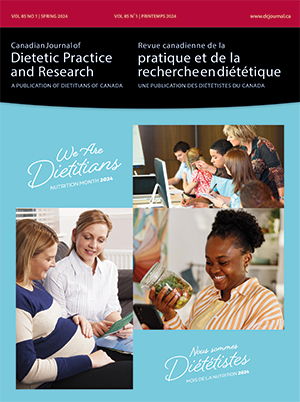Abstract
Purpose: To explore the impact of the COVID-19 pandemic on Nova Scotian dietitian’s roles, responsibilities, and professional development needs.
Methods: We conducted a province-wide, online, exploratory survey with registered dietitians during the initial waves of the COVID-19 pandemic. Differences were explored with descriptive statistics by work sector (hospital/acute care; primary health/community or public health (PH); long-term care [LTC]; other [e.g., private practice, retail]).
Results: Dietitians (n = 122) reported being most frequently challenged by stress and anxiety, changing work expectations, and rapidly evolving safety protocols during the pandemic. Those working in PH, primary health, and LTC reported experiencing more work responsibilities, more change, and perceived less employer support than dietitians in other sectors. Despite the identified challenges, most participants (70.7%) felt their education and training were sufficient to take on these new work roles. Primary and PH dietitians, however, more frequently perceived their skill sets to be under-utilized than other sectors. Key learnings from practice identified as being important for dietetic education included qualities such as resilience, problem-solving, flexibility, and self-care.
Conclusion: These findings will be of interest to health administrators, professional bodies, and academic institutions to inform strategies for strengthening dietetic practice, building resilience, and preparing for future emergencies.
Résumé
Objectif. Explorer l’impact de la pandémie de COVID-19 sur les rôles, responsabilités et besoins de développement professionnel des diététistes de la Nouvelle-Écosse.
Méthodes. Pendant les premières vagues de la pandémie de COVID-19, nous avons mené à l’échelle de la province une enquête préparatoire en ligne auprès de diététistes. Les différences ont été explorées à l’aide de statistiques descriptives par milieu de travail (hôpital/soins de courte durée; santé primaire/communauté ou santé publique [SP]; soins de longue durée [SLD]; autres [ex. pratique privée, détail]).
Résultats. Les diététistes (n = 122) ont déclaré avoir été le plus souvent confrontés au stress et à l’anxiété, au changement des attentes professionnelles et à l’évolution rapide des protocoles de sécurité pendant la pandémie. Les personnes qui travaillaient en SP, en santé primaire et en SLD ont rapporté avoir plus de responsabilités professionnelles, subir plus de changements et percevoir moins de soutien de la part de l’employeur que les diététistes des autres milieux. Malgré les défis identifiés, la plupart des participants (70,7 %) étaient d’avis que leur éducation et leur formation étaient suffisantes pour assumer ces nouveaux rôles. Toutefois, les diététistes des milieux de la santé primaire et de la SP percevaient plus souvent que leurs compétences étaient sous-utilisées, par rapport aux diététistes des autres secteurs. Les principaux enseignements tirés de la pratique et jugés importants pour la formation en diététique comprenaient des qualités telles que la résilience, la résolution de problèmes, la flexibilité et l’autoprise en charge de la santé.
Conclusions. Ces résultats intéresseront les administrateurs de la santé, les organismes professionnels et les établissements de formation universitaire, car ils permettront d’élaborer des stratégies pour renforcer la pratique de la diététique, développer la résilience et se préparer aux futures urgences.



